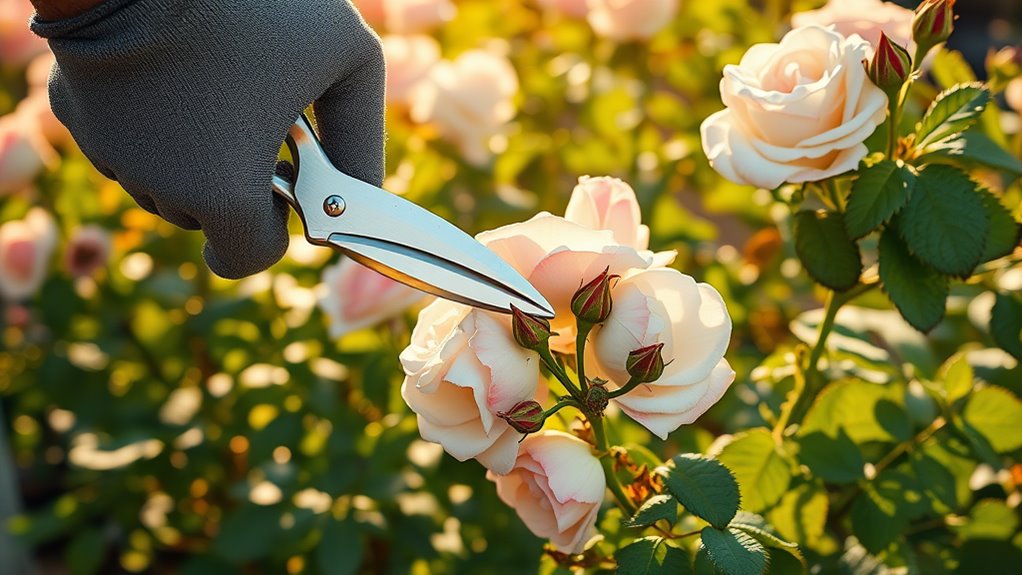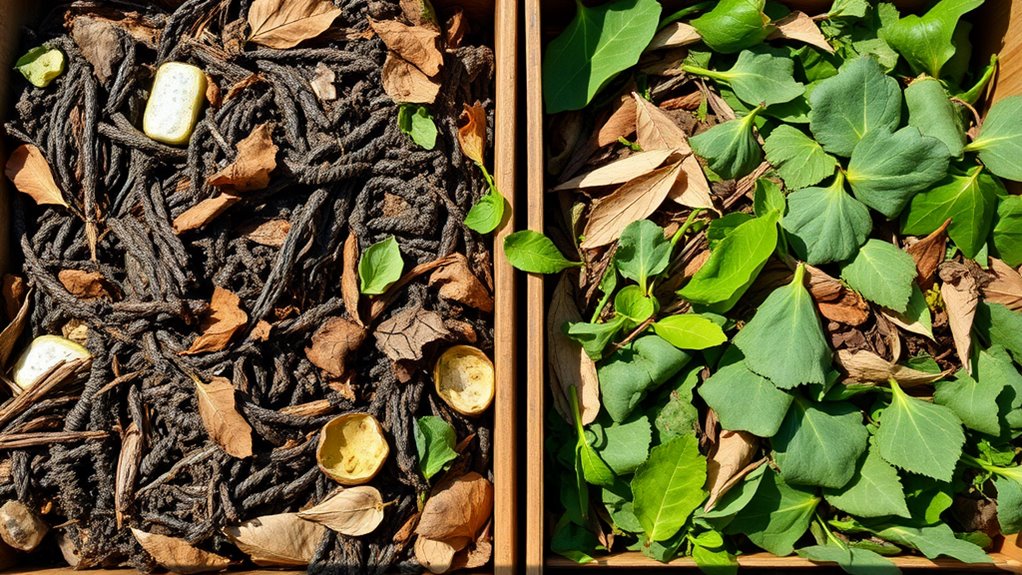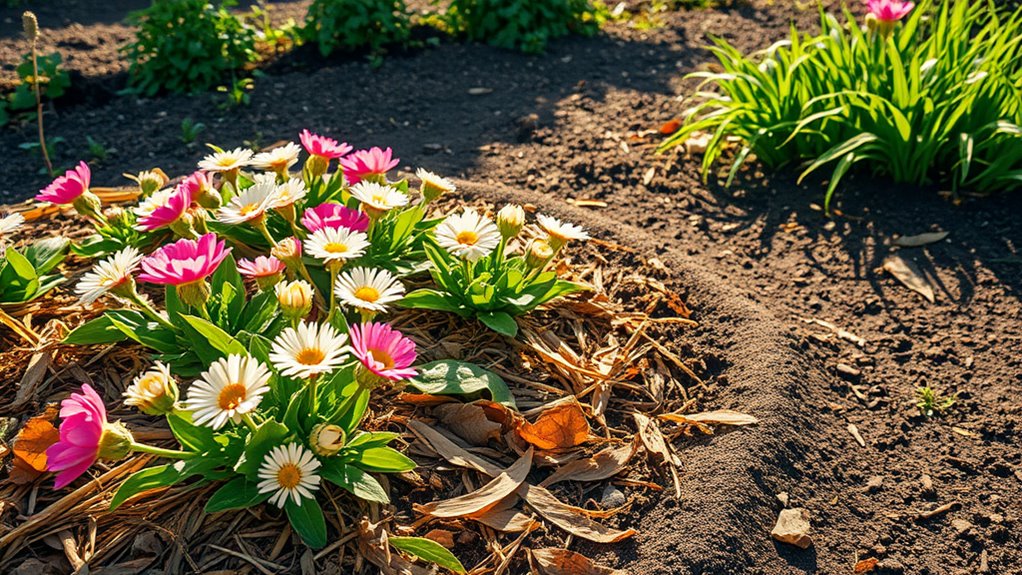10 Organic Gardening Hacks Farmers Don’t Want You to Know!
Revolutionize your garden with these 10 secret organic hacks that farmers won’t share! You’ll repel pests using simple garlic spray or vinegar traps, build a DIY compost bin from scraps for nutrient-rich soil, and pair plants like basil with tomatoes for natural protection. Save water with mulch and drip irrigation, then boost growth with homemade fertilizers from kitchen waste. These tips make gardening a breeze—uncover the rest and elevate your yields today!
Key Takeaways
- Use garlic spray from crushed cloves to naturally repel aphids and other pests without chemicals.
- Build a compost bin from pallets to turn kitchen scraps into free, nutrient-rich fertilizer.
- Implement drip irrigation to deliver water directly to roots, saving up to 50% more than traditional methods.
- Pair basil with tomatoes to deter insects and enhance flavors through companion planting.
- Brew compost tea from vegetable scraps to boost plant growth and soil health naturally.
Natural Pest Control With Everyday Items
While pests can wreak havoc on your organic garden, you’ll easily tackle them with simple everyday items like garlic, vinegar, or dish soap.
As key organic gardening tips, whip up a garlic spray by crushing cloves and mixing with water to repel aphids and other bugs naturally.
Set vinegar traps to lure and drown fruit flies effectively.
For stubborn pests, combine dish soap with water for a safe, instant spray that eliminates them on contact.
These straightforward methods keep your garden thriving without chemicals, empowering you to grow healthier plants with enthusiasm!
Incorporating these staples helps ensure a garden ecosystem that supports beneficial insects alongside your plants.
Experiment and enjoy the results.
For additional natural pest control, consider using natural herbs like basil to effectively deter insects in your garden.
DIY Compost Techniques for Rich Soil
You’re ready to boost your garden’s soil with DIY compost techniques that turn kitchen scraps into nutrient-packed gold.
First, build your own compost bin using everyday materials like wood pallets or wire mesh for a cost-effective setup.
Next, layer organic waste such as leaves and vegetable peels to create the perfect mix for fast, efficient decomposition. This method can transform your kitchen waste into nutrient-rich soil that supports thriving plant growth.
To maximize benefits, incorporate kitchen scraps like fruit peels and coffee grounds to enhance soil health and promote sustainable gardening.
Building Compost Bins
Building your own compost bin is an exciting way to turn everyday kitchen scraps into nutrient-rich soil for your garden.
It’s a budget-friendly project that lets you recycle waste while enhancing your soil’s fertility. You’ll love how easy it’s to create one that fits your space.
-
Gather simple materials: Use pallets, wire mesh, or plastic barrels to start building quickly.
-
Choose the right size: Aim for at least 3x3x3 feet to maintain heat and speed up decomposition.
-
Ensure proper airflow****: Drill holes or add slats so oxygen circulates effectively.
-
Make it accessible: Add a hinged lid or removable front for easy mixing.
-
Secure it well: Use stakes or ties to keep your bin sturdy against weather.
Layering Organic Waste
With your compost bin ready, layering organic waste is the key to creating nutrient-rich soil that boosts your garden’s health.
Start by adding a thick layer of browns like dried leaves or cardboard for carbon—aim for 4-6 inches. Top it with greens such as kitchen scraps or grass clippings for nitrogen, keeping layers balanced.
Moisten each one lightly, then repeat, ensuring good airflow to speed decomposition. You’ll minimize smells and pests while building a hot pile that breaks down fast.
Get excited—your DIY compost will yield fertile soil, making your plants grow stronger and harvests bountiful!
Companion Planting for Healthier Crops
Companion planting offers a smart way to supercharge your garden’s health, as certain plant pairings naturally deter pests, enhance growth, and boost yields—all while keeping things organic and eco-friendly. Increase crop yields can be achieved by leveraging these time-tested strategies that promote a balanced ecosystem in your garden.
You’ll discover how these clever combinations make your garden more resilient and productive, turning you into a savvy organic grower.
This approach draws from scientific principles that underpin how specific plant interactions can lead to enhanced growth and pest deterrence.
- Pair basil with tomatoes to naturally repel insects and improve flavor.
- Plant marigolds around vegetables to ward off nematodes and boost soil health.
- Grow beans alongside corn for mutual support and nitrogen fixation.
- Interplant onions with carrots to confuse pests and reduce damage.
- Use chives near roses to protect against aphids and enhance blooms.
Water-Saving Methods in Organic Gardens
You’re eager to conserve water in your organic garden, so let’s start with drip irrigation basics, where you’ll deliver water directly to plant roots, minimizing waste and boosting efficiency. Additionally, avoiding common mistakes in watering can prevent issues like overhydration and support robust plant development.
Next, you’ll love how mulch helps retain soil moisture by creating a protective barrier that reduces evaporation and keeps your plants thriving.
To maximize your garden’s health and productivity, try an innovative watering schedule that enhances efficiency and saves water.
Drip Irrigation Basics
Water-saving methods like drip irrigation can transform your organic garden by delivering water directly to plant roots, minimizing waste and boosting efficiency.
It’s straightforward to set up and keeps your plants hydrated without runoff. You’ll save time and enjoy healthier growth with this smart technique.
- Choose a system tailored to your garden’s size and layout.
- Install emitters directly at the plant base for targeted watering.
- Use a simple timer to automate and control water flow.
- Regularly inspect and clean lines to prevent clogs.
- Track your water usage to celebrate the savings and eco-benefits.
Get started today—your garden will thrive with less effort!
Mulch for Water Retention
Just as drip irrigation delivers water precisely, mulch locks it into your soil for longer.
You’ll cut evaporation by covering your garden beds with organic materials like straw, leaves, or bark. Apply a 2-4 inch layer around plants to suppress weeds and maintain moisture levels, saving you time and water.
It’s simple: spread it evenly, and you’ll notice healthier soil and reduced watering needs.
As mulch decomposes, it enriches nutrients naturally, boosting your garden’s vitality.
Get excited—embrace this hack for a thriving, eco-friendly oasis that conserves resources effortlessly!
Homemade Fertilizers From Kitchen Waste
While many gardeners overlook their kitchen scraps, you can easily turn them into nutrient-packed fertilizers that boost your plants’ growth. By incorporating an organic fertilizer recipe from a helpful blog post, you’ll grow bigger, stronger plants with easily accessible ingredients.
This eco-friendly method saves money, reduces waste, and supercharges your soil for healthier, vibrant gardens—let’s get started!
Additionally, incorporate banana peel fertilizer to naturally promote healthier growth in your plants.
-
Bury banana peels near plants for a potassium boost that enhances fruiting and overall vigor.
-
Crush eggshells and mix them into soil to supply calcium, strengthening stems and preventing deficiencies.
-
Add coffee grounds to beds for nitrogen-rich amendments that promote lush, green foliage.
-
Compost vegetable scraps like carrot tops to create nutrient-dense humus that improves soil texture.
-
Steep fruit rinds in water for a simple liquid fertilizer that encourages blooming and growth.
Weed Management Without Chemicals
Weeds can quickly overrun your garden, but you don’t have to rely on chemicals to keep them in check—embrace these simple, natural strategies that protect your plants while promoting a healthier ecosystem. Start by mulching to block sunlight, hand-pulling for precision, or using boiling water for quick kills. These methods keep your space thriving and eco-friendly! To further safeguard your garden from pests, integrate natural pest control techniques that align with these eco-friendly practices. (99 words)
As highlighted in eco-friendly approaches, incorporating healthy garden maintenance tips can further enhance weed prevention and overall plant vitality.
| Strategy | Tips |
|---|---|
| Mulching | Cover soil with straw to smother weeds and retain moisture. |
| Hand Pulling | Pull after rain when soil is loose for easy removal. |
| Boiling Water | Pour on weeds in paths to kill roots instantly. |
| Companion Planting | Grow dense crops like beans to crowd out invaders. |
You’ll love how these hacks make weeding fun and effective! (99 words)
Seed Germination Tricks for Success
You’ve got some simple tricks to boost your seed germination success, starting with pre-soaking seeds to speed up sprouting.
Next, create your own DIY germination setup using everyday items for a cost-effective boost.
Don’t forget to monitor soil moisture closely, as it ensures your seeds thrive and grow strong right from the start.
Pre-Soak Seeds
One of the easiest ways to boost seed germination is by pre-soaking them overnight, which softens the seed coat and speeds up the sprouting process.
You’ll love how this hack gives your seeds a head start, making your organic garden thrive with minimal effort.
-
Pick the right seeds: Choose hard-coated ones like beans or peas for best results.
-
Use clean water****: Opt for filtered or rainwater to keep it natural and chemical-free.
-
Time it perfectly: Soak for 8-12 hours to avoid over-softening.
-
Check for readiness: Look for swelling or the first root tips emerging.
-
Enhance absorption: Add a pinch of compost tea for extra nutrients and enthusiasm.
DIY Germination Setup
Building on your pre-soaked seeds, you can easily set up a DIY germination station that boosts sprouting success with everyday items.
Grab a plastic bag, paper towels, and a warm windowsill. Dampen the towels lightly, arrange your seeds evenly on them, then seal the bag to trap humidity and warmth.
This creates an ideal microclimate for quick sprouting—watch those seeds pop up in days! You’ll save money and space while maximizing germination rates.
Experiment with different setups to find what works best for your favorites. It’s fun, foolproof, and empowers your organic journey!
Monitor Soil Moisture
Once your seeds start sprouting, keeping soil moisture in check becomes essential for strong germination. This balance prevents drying out or waterlogging, helping your seedlings thrive with robust roots and vibrant growth.
You’ll master it with these simple, effective tips:
-
Feel the soil: Stick your finger in an inch deep—if it’s dry, water immediately to avoid stress.
-
Use a moisture meter: Grab an affordable one to get precise readings and act fast.
-
Water in the morning: This lets excess moisture evaporate, reducing fungal risks.
-
Add organic mulch: Layer straw or leaves to retain moisture naturally and efficiently.
-
Watch for signs: Yellowing leaves mean adjust watering to keep things optimal.
Boosting Plant Growth With Natural Boosters
While you’re nurturing your organic garden, natural boosters like compost tea and worm castings can supercharge plant growth by delivering essential nutrients efficiently.
You’ll brew compost tea from kitchen scraps and water, then apply it to roots for a nutrient boost that enhances root development and resilience.
Don’t forget worm castings; mix them into soil to foster microbial activity, leading to lusher leaves and stronger stems.
Experiment with these boosters to see your plants thrive—it’s simple, effective, and eco-friendly, turning your garden into a vibrant haven with minimal effort!
Mulching Strategies for Soil Health
Mulching keeps your soil healthy and productive, building on the nutrient boosts you’ve added to your garden. This simple technique retains moisture, regulates temperature, and suppresses weeds, making your organic setup thrive with minimal effort.
You’ll love how it boosts soil microbes and prevents erosion for long-term gains.
-
Choose organic mulches**** like straw or leaves to enrich soil as they break down naturally.
-
Apply a 2-4 inch layer**** around plants to lock in moisture and block weeds effectively.
-
Time your mulching**** for spring and fall to protect roots from extremes.
-
Mix in compost for added nutrients, enhancing microbial activity right away.
-
Monitor and refresh mulch regularly to maintain its benefits and adapt to your garden’s needs.
Harvesting Tips for Maximum Yield
As your garden flourishes from your mulching efforts, you’ll want to master harvesting techniques that maximize your yield and savor every bit of your organic bounty.
Time your picks for early morning when plants are hydrated and flavors peak—check for ripeness by color and firmness. Use sharp shears to snip cleanly, preventing damage and encouraging regrowth.
Rotate through beds to avoid over-picking, and handle produce gently to minimize bruising. Wash and store items promptly in cool spots; you’ll enjoy fresher, nutrient-packed results that make your efforts truly rewarding!





